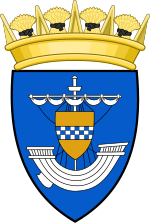| Renfrewshire | |
|---|---|
 Renfrewshire within Scotland | |
| Area | |
| • 1975 | 245 sq. miles (634 sq. km) (27th) |
| Population | |
| • 2014 est | 346,470 |
| • 1981 est | 366,509 |
| History | |
| • Origin | Lordship of Strathgryfe |
| • Succeeded by | Strathclyde Region |
| Status | Local government county (until 1975) Lieutenancy area (1794-present) Land registration county (1996-present) |
| Chapman code | RFW |
| Government | County: Renfrewshire County Council (1890–1975) District: Eastwood District Council, Renfrew District Council, Inverclyde District Council (1975–1996) Modern: East Renfrewshire Council, Inverclyde Council, Renfrewshire Council (1996-present) Lieutenancy: Lord Lieutenant of Renfrewshire (1794-present) |
| • HQ | Renfrew (county town) Paisley (County Council headquarters) |
| • Motto | Avito viret honore ('Flourishing through ancestral honour')[1] |
 Coat of arms of the county council | |
Renfrewshire or the County of Renfrew is a historic county, registration county and lieutenancy area in the west central Lowlands of Scotland. The lieutenancy area covers the three modern council areas of Inverclyde, Renfrewshire and East Renfrewshire, and this area is occasionally termed Greater Renfrewshire to distinguish it from the modern council area called Renfrewshire. The historic county additionally included territory on the south-western edge of Glasgow which was gradually transferred to the administrative area of the city as it grew.
The county borders Glasgow and Lanarkshire to the east and Ayrshire to the south and west. The Firth of Clyde forms its northern boundary, with Dunbartonshire and Argyll on the opposing banks.
Renfrewshire's early history is marked by ancient British and Roman settlement. Renfrewshire can trace its origin to the feudal lands at Strathgryfe granted to Walter FitzAlan, the first High Steward of Scotland. Renfrewshire was created as a shire in the early fifteenth century, having previously been part of Lanarkshire. The county was named after its original county town, the royal burgh of Renfrew.
During the Industrial Revolution, many of the larger towns became important centres of commerce and manufacturing. The goods produced were chiefly cottons, calicos and silks building on the county's long weaving heritage. Other industries such as ship building, distilleries and printworks also contributed to the economy. Paisley grew to become the largest urban and commercial centre in the county by some margin. Renfrewshire County Council existed from 1890 until 1975, and was based in Paisley.
Parts of the county, such as Pollokshaws in 1912 and Nitshill in 1926, were incorporated into Glasgow during the early 20th century as the city expanded. Renfrewshire was abolished for local government purposes in 1975, being replaced by the Strathclyde region and three lower-tier district councils. These were in turn abolished in 1996, since when the Renfrewshire area has been governed by the three council areas of Renfrewshire, East Renfrewshire and Inverclyde.
- ^ A.C. Fox-Davies, Public Arms of the United Kingdom of Great Britain and Ireland (1915)